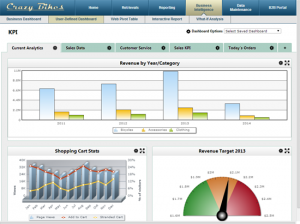 Summary: We’re in the middle of a data explosion. The modern business has access to more data than ever before, and it’s only growing. However, not every business knows how to use this data to its fullest potential. In the second part of this two-part article, we explore a few more ways to get more value out of your data.
Summary: We’re in the middle of a data explosion. The modern business has access to more data than ever before, and it’s only growing. However, not every business knows how to use this data to its fullest potential. In the second part of this two-part article, we explore a few more ways to get more value out of your data.

The problem: Most do not know how to use it.
As mentioned in this article, many companies today are “data rich but insight poor.” They have access to mountains of data, but are not maximizing its potential.
How can you get more value out of your data? In the first part of this article, we explored these 5 tips:
- Make sure it’s clean
- Put a system in place
- Incorporate data from external sources
- Incorporate Machine learning and AI
- Know your customer
Today, let’s take things a step further. Here are 5 more tips to maximize the value of your business data.
1. Put a standardized process in place

Let me explain: Any good self-service Business Intelligence tool provides a fair amount of flexibility. It lets users create visualizations that are customized to their needs.
But, is this a good thing?
It depends. If users are creating reports and visualizations for their own use, then customization is a benefit. It helps them analyze data more effectively.
However, if users are creating reports and visualizations for consumption by others, it can have the opposite effect. Analyzing multiple reports created in different ways can feel like comparing apples and oranges. Just imagine if you’re a business leader, and must decipher different reports created in different formats. It can slow down your analytics and even lead to misinterpreted data.
It’s a common problem. As explained below, businesses create standard processes for strategic functions, but many do not have processes in place for data visualization. To maximize your data’s impact, you must treat your analytics as a strategic function.
“I think we can all agree with the statement ‘data is strategic,’ says Lee Feinberg, President and Founder of DecisionViz.com. “Without going through a rigorous mathematical proof, it follows that ‘data visualization is strategic’ since that is the medium by which everyone in your organization will communicate the value and impact of the data. There are serious implications to this statement that most companies are not addressing.
Think about how your team approaches visualization today. Regardless of which application you’re using, it’s likely each person produces visualizations in their own unique way. I’m not talking about templates or look and feel, but the way people go about the work of having an idea and getting to a final deliverable.
Finance is a strategic function. Imagine if balance sheets and income statements were managed in completely different ways. Marketing is a strategic function. Imagine if something as fundamental as the 4 Ps was not followed. IT is a strategic function. Imagine if teams developed and tested software however they liked. Each of these strategic functions follows a consistent process, but few organizations follow a process when it comes to data visualization.”
2. Minimize the amount of data you’re analyzing
The modern business has access to more data than ever before. This is widely accepted as a good thing. But, for many, it’s not. It’s just overwhelming.
This article in Forbes sums up the problem nicely: “But in the rush to avoid being left behind, I also see that many companies risk becoming data rich but insight poor. They accumulate vast stores of data they have no idea what to do with, and no hope of learning anything useful from.”
Now, I’m not saying you shouldn’t capture data. I’m saying that you should limit the amount of data you put in front of decision-makers. Don’t try to give them every data point you have. Cut out the fluff. Give them the data they need to see on a day-to-day basis. Identify the KPIs that drive your business objectives, and focus on those.
“My tip to maximize the value you’re getting is actually to minimize the amount of data you’re analyzing day to day,” says Sarah Hewitson, Co-Founder of neatly.io. “You can do this by clearly identifying what your business objectives are and thus the KPIs that help you measure these objectives. This will help you stay focused on work that helps you reach those goals. For example if your objectives are increase revenue, and reduce CPA, then you really only need to track two KPIs, revenue and CPA.Of course, when working on specific campaigns or processes within your business you will need to use other data to provide context and dig deeper, but generally for a day to day glance at your business, minimizing will help you to be more efficient and stay on track.”
3. Make your KPIs visible
 To maximize the value of your data, your KPIs must be clear and visible. Once you’ve identified your most important KPIs, the next step is visibility. Put them in front of everyone in your business.
To maximize the value of your data, your KPIs must be clear and visible. Once you’ve identified your most important KPIs, the next step is visibility. Put them in front of everyone in your business.
How? I know of some companies that print out daily KPIs and put them in high-traffic areas (like the break room). Other companies mount monitors throughout their office that display real-time data in relation to their KPIs. Others embed dashboards into the software products that employees use everyday.
Those are just a few examples, but I think you get the point. Your KPIs must be placed in front of your users, and be easily understood. What does that look like? Here’s a great example of clear KPIs being placed in front of users.
“We make all our key performance indicators (KPIs) transparent and tracked and viewable on a daily basis,” says Kean Graham, CEO of MonetizeMore. “Each KPI is data driven and automatically loaded onto a consolidated Google sheet that every team member can view. There is a main KPI for each department and an overarching KPI for the whole company: Net Revenues. Overall and department KPIs are categorized into four levels:
Green: Exceptional performance
Blue: Very good performance
Yellow: Room for improvement
Red: Emergency, fix immediatelyEvery department KPI contributes to the overall KPI and we communicate this to each department on a regular basis. For example, if the support team achieves a high KPI score of high customer satisfaction out of 10, then sales funnel conversion rates will be high and net revenues will grow faster. Each department has a clear view of how their KPI performance affects the overall KPI performance and grows the company.”
4. Make data access pervasive
Who has access to your business data? Is it a company-wide effort, or is it limited to certain departments?
It’s a problem that we see across many businesses. They treat Business Intelligence as an IT-specific function. Users request reports from IT…and wait.
Now, that’s changing. With the rise of self-service tools, BI is turning into a business function. End users can (and should) create reports and analyze data on their own.
If you want to maximize the value of your data, BI cannot be a bottleneck. You must expand its reach across your entire organization. Give employees the tools and training necessary to gain insights from your data.
“Give broader team access to training and tools, evangelize data-driven decision making,” says Ryan Farley, Co-Founder, LawnStarter Lawn Care. “One of the most impactful things we did was host weekly evening training sessions, where anyone in the company could come and learn the basics of data analysis. This did two things. For one, it gave them the tools to use data more effectively in their daily workflow. Secondly and more importantly, it showed individuals the power of data and how fun and impactful it is to use data in your decision making.”
5. Look at internal data

That being said, many companies have data that could provide value that just isn’t analyzed. They’re so focused on the product and sales data, they ignore the data they generate internally.
What can you do? Look for areas that could provide value that aren’t currently being analyzed. As explained below, one area to look is your employee data. You’ll be surprised at how much value you can find.
“Data can help companies optimize every aspect of their business from lifetime value of a customer and cost of acquisition to employee turnover and office supply usage,” says Rachel Honoway, Partner, Rust Built Ventures. “The biggest problem that most companies have with becoming truly data-driven is that they simply don’t track and analyze enough activities.
Take employee turnover for example… your HR department probably has a good idea of how many people have come and gone from the company over the last quarter. But, do they know how many months each person was employed before they exited? Do they know how many hours of training each employee received, the last time they each received a review, a raise, or a new manager?
As you can see in my example, “data” isn’t limited to statistical figures. It’s information that’s recorded in a standard format.
Companies that track as many activities as they can and analyze the trends can truly be called data-driven.”
Summary
These are just 5 tips to get more out of your data, but the list could be much longer. If you would like to add anything to this list, I’d love to hear it. Feel free to share in the comments.
Pingback: How to Get More Out of Your Company's Data
Pingback: Methods to get essentially the most out of your enterprise information | Tech News